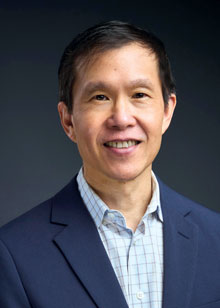APA’s Toolkit Encourages Reporters to Reject AAPI Stereotypes
Abstract
A new toolkit for reporters outlines the mental health ramifications of poor media representation of the Asian American/Pacific Islander (AAPI) community, as well as the discrimination and racism that result.
As a fourth-generation San Franciscan, William Wong, M.D., grew up hearing firsthand about the systemic racism that three generations of his Chinese American family experienced. Their lives were deeply impacted by the Chinese Exclusion Act of 1882, which banned Chinese laborers from immigrating to the United States, and the Page Act of 1875, which prohibited Chinese women from entering the country.

William Wong, M.D., saw discrimination toward the AAPI community intensify during the COVID-19 pandemic and reached out to APA to see what the psychiatric community could do to address it.
In 2020, he saw a new wave of Asian American–directed racism sweep the country. Even before the COVID-19 pandemic lockdowns were implemented, Wong was confronted with discrimination when ordering ride shares. Then, after the lockdowns went into effect, drivers would slow down their cars and yell at him when he was out for walks. “This was in my own neighborhood,” said Wong, a psychiatrist with Kaiser Permanente in San Mateo, Calif. “It was quite shocking to me.”
As Wong contemplated what could be done about these issues, so, too, did Seeba Anam, M.D., an associate professor of psychiatry and behavioral neuroscience at the University of Chicago. “I’m a big consumer of media, but I have never really found anything that reflects my experience or the experiences of my family or friends,” Anam said. “What I did find was discrimination modeled through stereotypes.” She saw the danger of this misrepresentation again during the early days of the COVID-19 pandemic, when stereotypes and discrimination in the media resulted in violence.
In seeking to address these problems and raise public awareness about their mental health ramifications, Wong and Anam each reached out to APA and were connected through the chair of the Caucus of Asian American Psychiatrists, Dora Wang, M.D. Together, Wong and Anam worked closely with APA’s divisions of Communication and Diversity and Health Equity and co-wrote a new toolkit for reporters that outlines best practices for reporting on the Asian American/Pacific Islander (AAPI) community and explains the mental health impacts of media misrepresentation. They presented the toolkit to the Asian American Journalists Association, then released it to the public last November.
“Media is a core part of how we learn about the world around us,” Anam said. “Stereotypes dehumanize communities and allow room for mistreatment. When you subvert stereotypes and portray communities with nuance or as multidimensional characters, it makes a huge difference to people’s internal sense of self and how they may be seen and treated by others.”
The toolkit gives journalists practical advice on reporting on the AAPI community, such as including the perspectives of AAPI individuals for diversity in general stories, reminding the audience that the community is deeply rooted in America, and clearly identifying acts of racism. It also emphasizes the importance of people seeing themselves depicted accurately, which “allows them to better relate to health or other messaging.”
The toolkit includes startling data points, such as that 84% of Asian Americans say they worry about being the victim of a mass shooting, and more than 20% of Asian Americans say they worry daily or almost daily that they might be threatened or attacked because of their race or ethnicity. Both Anam and Wong described stereotypes and misrepresentations of the APPI communities in media as dangerous because they prime the public to develop discriminatory views, which in turn leads to acts of violence.
Media misrepresentation also encourages a sense that members of the APPI community do not belong, Wong said. When the COVID-19 pandemic was initially blamed on China, a significant number of Americans immediately began blaming even their Asian American neighbors. “That’s because they did not view members of the AAPI community as being Americans or belonging,” he explained. “It meant that people like me, a native-born American of Asian descent who has lived here my whole life, were discriminated against.” Further, inaccurate media representations cause the public to see the APPI community as monolithic, rather than the massively diverse group of people that it comprises. “There’s a huge heterogeneity within the cultures, social norms, and social determinants of health,” Anam pointed out. Yet that diversity is rarely portrayed accurately in the media.
In addition to Wong and Anam, the co-authors of the toolkit include Ingrid Chen, M.D., chief resident at Kaiser Permanente-Oakland; Divya Chhabra, M.D., a clinical assistant professor in New York University’s Department of Child Psychiatry; and Nikhita Singhal, M.D., a psychiatry resident at the University of Toronto.
Anam and Wong encourage fellow APA members who are similarly passionate about an issue to also work with APA leaders and staff. “We were very fortunate to be connected with APA’s staff because they stewarded us through the development of this toolkit,” Anam said. “We worked together as a team.” ■



